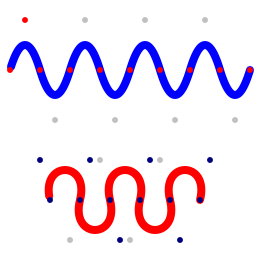
function FlattenQSpline(const pts: TPathD): TPathD;
This function converts QSpline points into a flattened path. It loosely approximates the 'T' command inside the 'd' property of an SVG path. In essence, a QSpline 'pts' array represents a series of points that define a series of joined quadratic bezier curves.
The first three coordinates of the spline represent the starting point, control point, and end point of the first sub-curve (just like a quadratic bezier curve). Subsequent points represent the end points for following sub-curves. Control points for following sub-curves are derived from the very first control point; with each new control point being the control point of the preceding sub-curve reflected across its end point.
uses
Img32, Img32.Fmt.PNG,
Img32.Vector, Img32.Draw;
...
var
img: TImage32;
path: TPathD;
pts: TPathD;
ghostPt: TPointD;
begin
img := TImage32.Create(256,256);
//create and draw a BLUE QSpine path
pts := MakePathI([10,70, 25,20,
40,70, 70,70, 100,70, 130,70, 160,70,
190,70, 220,70, 250,70]);
path := FlattenQSpline(pts);
DrawLine(img, path, 8, clBlue32, esRound);
//show where the 'pts' are too
for i := 0 to high(pts) do
DrawPoint(img, pts[i], 3, clRed32);
//and show the derived control points
ghostPt := pts[1];
for i := 2 to high(pts) do
begin
ghostPt := ReflectPoint(ghostPt, pts[i]);
DrawPoint(img, ghostPt, 3, clSilver32);
end;
//CODE FOR (RED) CSPLINE OMITTED
img.SaveToFile('splines.png');
img.Free;
end;
In the image below the blue curve is a QSpine. The red dots indicate the user defined control and end points, and the pale gray dots indicate virtual control points (ie derived from preceding control points).

FlattenCSpline, FlattenQBezier
Copyright ©2010-2023 Angus Johnson - Image32 4.8 - Help file built on 16 Apr 2025